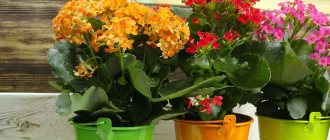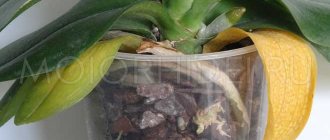Kalanchoe has recently become extremely popular. There are several explanations for this. The first explanation is the decorative qualities of Kalanchoe. The second explanation is the medicinal qualities endowed with two types of Kalanchoe - pinnate and degremona. Kalanchoe juice is used in surgery, dentistry, otolaryngology, in obstetric and gynecological practice, for cosmetic purposes, to help cope with the consequences of gastritis and ulcers. The herbal medicine has regenerating and anti-inflammatory properties. There are more than two hundred varieties and hybrids of Kalanchoe in the world, but the most commonly bred species are: pinnate, blossfelda, calandiva, and degremona.
Kalanchoe is an unpretentious houseplant that requires minimal attention. Following the basic rules will give good results:
- Sufficient amount of sunlight
- The room temperature should not be lower than 15 ºC and higher than 29 ºC
- Optimal amount of moisture
- The air should not be too dry and not too humidified
- Regular pruning of the plant and its faded parts
- Regular soil fertilization
- Protecting a plant from pests or controlling them
Kalanchoe pot
An equally important issue is the pot and the soil mixture in it. Both a plastic and a ceramic pot with small protrusions at the bottom are quite suitable, since Kalanchoe does not react well to stagnation of moisture. If you take the most ordinary clay pot, then this will be the best option for this plant. It is advisable to put drainage in the pot. There should be minimal free space in it.
Planting a small plant in a huge pot in the hope that the flower will grow over time is absolutely not possible. It is unacceptable to plant any other plant, flower or tree in the same pot with Kalanchoe. As for the contents of the pot, store-bought soil for succulents is quite a suitable option. You can try to create the soil yourself. To do this, use humus (leaf soil), sand or perlite, peat, and put pebbles underneath. But for Kalanchoe, you can take a peat mixture or a universal one and add sand there. You can mix a universal store-bought mixture with sand, but it is important to remember that the soil in the pot should not dry out quickly.
Different methods of reproduction
Kalanchoe is a plant that reproduces very easily. You can get new flowers in a variety of ways. The process of flower propagation is so simple that anyone can handle it. Plant propagation is carried out by children, seeds, stem and leaf cuttings, and offspring. Any method always gives good results. To propagate Kalanchoe by leaf, you can even use fallen old leaves, which take root incredibly easily.
Some varieties of the plant reproduce by children. Small daughter sprouts form on the leaves of Kalanchoe. Children look very much like adult plants. They have small leaves and roots. Adult succulents most often shed such buds themselves, which easily take root in the mother pot. Later they can be transplanted into another container. If you find formed shoots on the leaves, you can safely break them off and plant them in fertile soil.
Propagation by leaves can be carried out at any time of the year. A cut adult leaf is planted in a pot with a moist substrate. It is covered with a jar or glass on top. The leaf takes root in just a few days. Soon it will become an independent plant. Sometimes part of a leaf is used for propagation. It is buried in the ground and after some time a young plant develops from it.
What size pot do you need?
Store-bought Kalanchoe needs to be replanted within six months, preferably in early spring. The new pot should be a few centimeters larger than the previous one. This is the basic principle of transplanting such plants.
The best container size for Kalanchoe is approximately twelve to seventeen centimeters, depending on the variety and variety. You should not take a large and wide pot, since Kalanchoe has a small root system. Kalanchoe will develop well if it is carefully transplanted into a larger pot in early spring, adding fertile soil.
Folk signs
It is believed that a blooming Kalanchoe attracts good luck and prosperity to the home. The “babies” along the edges of the leaves resemble coins, and the abundance of flowers is associated with wealth.
In addition, it is believed that Kalanchoe makes the atmosphere in the house healthier. It “establishes” relationships between household members, and attracts couples to single people. The better the pet feels, the greater luck awaits its owner.
Best time to transplant
In early spring, you need to decide whether you need to replant the Kalanchoe. If you have free time, then this procedure will not be superfluous, but what if time is stressful? Then you need to find out whether the space of the pot is filled with roots. To do this, fluff up the soil, carefully lift the pot, and then remove the top layer of soil. Visually this is easy to determine. If the roots have grown greatly, you need to immediately buy or look in your bins for a larger pot and replant it.
In a very cramped pot, the plant will not be comfortable; the flower may slow down in development and even die. Another important fact is that it is advisable to replant in the spring, or at least in the fall. In other seasons, replant only if absolutely necessary.
Replanting a plant as a way to control pests
One of the reasons for an emergency plant transplant can be a variety of pests. Powdery mildew, gray mold, aphids, spider mites, mealybugs and other parasites can be destroyed even by so-called traditional methods. Thick soap suds can be an effective, simple and cheap way to control pests. To do this, you need to use laundry soap; you cannot use scented liquid soap. It is advisable to repeat the procedure several times. If this remedy does not help, you can use chemicals recommended by biologists, including derris and karbofos.
You can destroy scale insects and mealybugs using alcohol, smearing the places where pests accumulate. It is highly undesirable to transplant during the flowering period. This should be done only as a last resort, if the sick flower needs so-called emergency help. For example, if a plant has become ill with late blight rot, then you must immediately stop watering, treat the trunk and leaves, and if all these actions do not give the desired result, then transplant it into another pot, completely change the soil and, preferably, into a completely new pot. If it is not possible to treat the old pot well.
Diseases and pests
It happens that at home, Kalanchoe sometimes gets sick and is attacked by pests.
Aphid
The parasitic insect is dangerous because it sucks the juices out of the plant and can infect it with fungal infections. Aktara, a solution of ammonia, is used for processing.
Spider mite
Its presence can be identified by a small sticky web.
The pest quickly spreads throughout all shoots. To combat it, it is necessary to treat it with Aktara.
Diseases
With proper care, the flower rarely gets sick.
But if you water too often, root rot can occur, which causes the leaves to turn black. To eliminate the problem, you need to reduce the frequency of watering and let the soil dry out. Damaged leaves are cut off.
Kalanchoe and feng shui (feng shui)
In recent years, it has become fashionable to use Feng Shui knowledge when updating the furnishings in a house or apartment. Flowers play an important role in this process. A flowering plant in a beautiful ceramic pot will decorate any room. Kalanchoe will help improve your mood. To do this, the flower must be placed on a windowsill that faces the south or at least the southeast, southwest side.
Kalanchoe helps restore strength; for those who feel chronic fatigue and are forced to work through force, the flower will give strength for further activities. It should be placed in the bedroom. Kalanchoe is especially indicated for elderly people who are depressed. The flower will help you find inner balance and not fall completely into despair. The plant takes on negative energy. Plus, the flower cleanses the air well in the house and has antiviral and antibacterial properties.
Flowers in pots as part of the interior design
In modern offices, apartments and houses, there are often a lot of flowers in pots. Skillfully selected, they not only look great in various modern styles, but also greatly complement the decor of the premises. Some amateur flower growers allocate a separate space for flowers - like a mini-gallery - on balconies, verandas, part of the room, and decorate arches with flowers.
Of course, such compositions look great, if the space does not allow, then they green the space vertically as much as possible - by placing racks, stands and brackets, on which many pots of flowers are concentrated and, of course, window sills are used. Having experience in working with the formation of plant crowns, you can achieve various phytodesign finds and solutions that will make your home unique. Thus, we can say that flowers harmonize living and working spaces and improve energy in the home and office.
When can you plant a plant?
Planting and replanting of Kalanchoe is carried out in the spring. Usually this is April-May. With proper care, flowering ends during this period. When propagating Kalanchoe by cuttings, replanting is required several months after planting. It takes plants approximately 2–4 months to entwine an earthen ball with their roots. In the case of transplanting young plants, they focus not on seasonality, but on the speed of root growth.
Replanting must be done annually, since the plants have a high growth rate. Upon reaching the age of 3–4 years, transplantation can be carried out once every 2 years. When replanting is not carried out, be sure to replace the top 3–4 cm of soil with new nutrient soil, and also periodically top up the soil when it settles in the pot.
Living conditions depending on the season
The conditions of detention directly depend on what the owners want to get from the flower. If the goal is abundant flowering, then the Kalanchoe will have to be hidden in a dark room for one and a half to two months or covered with a dark film (simulating night) for 14 hours a day.
In addition, the air temperature should be close to autumn-winter (+7 at night and +15-16 during the day). Blooming Kalanchoe retains its appearance for several months in a row.
For the winter, the already rare watering is significantly reduced and fertilizing is not applied.
If there is no goal to achieve flowering, then the plant grows as usual, with the only difference being that the western or eastern window can be replaced with a southern one. Shoots that become very elongated due to insufficient winter light are pruned (Kalanchoe can be propagated with them).
Preparing for landing
For Kalanchoe, it is better to select plastic containers that have not been used before. There should be a sufficient number of drainage holes at the bottom of the container. The size of the pot depends entirely on the size of the plant. For example, it is better to transplant a young shoot into a container 2 cm larger in diameter.
If we are talking about adult specimens, then the size of the new pot should be such that the old one fits into it quite tightly. The fact is that the plant will bloom only in a fairly tight container. A large container will stimulate the development of the root system and foliage to the detriment of flowering. The pot must be disinfected before use.
For this purpose you can use:
- concentrated manganese solution;
- laundry soap;
- furatsilin solution (1 tablet per 50 ml of boiling water);
- boric acid.
Soil for Kalanchoe is prepared by mixing in a ratio of 4:2:1:
Soil disinfection is best done using a hot solution of wood ash. It will not only disinfect it, but also nourish it with useful minerals. It is prepared at the rate of 1 tbsp. l. ash per 1 liter of water. The mixture must be boiled, poured hot into the soil and mixed thoroughly. Next, the soil is dried so that by the time of planting it is sufficiently moist, but does not stick to your hands.
Drainage should also be prepared for Kalanchoe. It is best to mix expanded clay with perlite in a ratio of 1:0.5 and add 20% of the total mass of sphagnum moss. Before use, the mixture is poured with boiling water, then dried and crushed.
Reproduction by leaves and leaf blades
Some plant species have amazing properties. They can sprout not only from leaves and stems, but also from parts of leaf blades. Just plant a piece and it will give roots.
This type of reproduction will require special care. Since violation of technology will only lead to the sheet rotting. To begin, prepare a special soil mixture.
It will require leaf soil, humus, peat - they are taken in equal parts and mixed. Additionally, half of the river sand is added. This composition retains moisture for a long time.
The mixture is poured into a small pot and moistened well. A healthy leaf without a root is cut off from Kalanchoe. After which the plate is gently pressed into the soil.
Attention! It is important not to damage the sheet at this moment, otherwise it will begin to rot. The cut area is carefully covered with earth. Cover the pot with glass or a bag
It is necessary to control the level of soil moisture. Under the right conditions, a baby will form on the leaf plate
The pot is covered with glass or a bag. It is necessary to control the level of soil moisture. Under the right conditions, a baby will form on the leaf plate
The cut area is carefully covered with earth. The pot is covered with glass or a bag. It is necessary to control the level of soil moisture. Under the right conditions, a baby will form on the leaf plate.
Gradually it will get stronger and can be transplanted into another container. The mother leaf will gradually die on its own and dry up. A full-fledged miniature specimen of Kalanchoe will remain.
This propagation method is suitable for all varieties with fleshy, thick leaves. This option is very difficult, since if the technology is violated, the plate will rot or dry out. Therefore, you need to carefully monitor the condition of the seedling.
You can propagate Kalanchoe even with a piece of a leaf.
Leaf propagation
Some types of succulents grow well from a regular leaf. To do this, you need to cut off a healthy Kalanchoe leaf, along with the petiole - its length should be at least 2 cm.
After this, the cut is left to air dry. After which the leaf is planted in wet peat. The petiole is buried to its full length. It is advisable to cover the top of the pot with glass or cellophane.
For reference! Some claim that even a beginner can grow Kalanchoe from a leaf.
If you follow the technology, you can easily get a new plant specimen. You can try taking a fallen leaf for propagation. If it is not dry, it will produce roots.
Such a Kalanchoe will bloom only in a few years. Sometimes the leaf is germinated through water. To do this, it is placed in a container so that the petiole is constantly in contact with moisture.
After the roots appear, the leaf is carefully deepened into the soil for succulents for further strengthening.
Step-by-step guide to planting Kalanchoe at home
The planting pattern will differ depending on its goals. Kalanchoe can be planted in separate containers or in common ones, for example, when propagated by leaves or apical shoots, until a fairly strong root system is formed and the plants become stronger.
After the purchase
A month after purchase, if the plant does not bloom, begin replanting.
Step by step steps:
- The day before transplanting, water the plant.
- In pre-prepared, treated containers, place a layer of drainage of 1–2 cm, depending on the dimensions.
- Place a small amount of nutrient substrate on top of the drainage in a layer of 1–3 cm.
- Remove the plant from the pot along with a lump of earth.
- Shake off soil that comes off easily. Inspect the root system. If necessary, remove dead, too thin roots. Powder the sections with wood ash mixed in a 1:1 ratio with Fundazol.
- Place the plant in a new container, align it with the root collar - it should be 0.5 cm below the edge of the pot.
- Fill the voids with soil. Lightly compact it in the tree trunk circle.
- Lightly moisten the soil surface with a spray bottle with water at room temperature.
- Leave the transplanted plant in a shaded area for 3–5 days. After this time, you can move the plant to a permanent location.
Planting several Kalanchoes in one pot
For general planting, it is better to take an oblong square container. Prepared sprouts with already formed small roots are placed at a distance of 5 cm from each other in a row or planted two in a row. When planting 2 plants, leave a distance of 10 cm between pairs.
The procedure is approximately the same as in the previous case. The only difference is that you need to fill the entire pot with soil, and then make depressions in it of a size suitable for the root system.
After planting, you need to provide the plants with greenhouse conditions. To do this, the container is covered with transparent polyethylene. This approach contributes to faster adaptation of the roots to the soil. After 5 days, the shelter can be removed and the pot moved to a permanent place.
How to propagate from cuttings and leaves
Propagation of Kalanchoe by cuttings is not only possible, but also necessary. During flowering, the stems stretch out, but when the Kalanchoe fades, the flowers fall off and the plant becomes somehow bald and inconspicuous.
Therefore, this elongated part of the shoot is cut off, placed in the ground and watered abundantly, or you can first germinate the roots in a container with water. You should carefully approach the choice of cuttings, since the further appearance of the plant and its shape will depend on the cuttings that you germinate.
You need to choose a straight shoot about 8 centimeters long with beautiful and even leaves and short internodes. The cuttings are planted in such a way that the leaves seem to lie directly on the surface of the soil.
When the cuttings have roots, you need to pinch the seedling - this will stimulate it to grow and further develop a lush Kalanchoe bush. Propagation by cuttings renews the plant itself and stimulates it to further growth and development.
Kalanchoes, which have fleshy leaves, can be propagated by leaflets. Any leaf is suitable for propagation, even an old one that has fallen off the trunk.
In order for roots to appear, you need to bury the stem of the leaf in damp sand and cover it with a transparent cap and place it in a bright place to create greenhouse conditions. Reproduction of Kalanchoe by leaves occurs best in late May and early June.
Method of propagation by seeds
Seeds are grown mainly for those species of Kalanchoe that are considered exotic and difficult to obtain.
To begin with, prepare the soil; this substrate should mainly consist of peat-sandy soil. The seeds are scattered on the surface of the substrate and covered with glass. This is best done at the end of winter or early spring.
The container, covered with glass, is placed in a bright place and the temperature is maintained at 20 degrees, this temperature is optimal for seed germination. Seedlings need to be watered and the seeds ventilated on time. After the seedlings become stronger, they are transplanted to a permanent place of growth.
Features of care after planting
Kalanchoe tolerates planting/transplanting normally. But after it you need to provide the plant with the most comfortable conditions.
Location and conditions of detention
Kalanchoe should be protected from direct sunlight. It is best to install it on eastern or western window sills with abundant diffused lighting.
The temperature in the summer should be maintained within +20. +28°C, in winter - +12. +18°С. During the cold season, Kalanchoe enters a dormant period.
The humidity regime is also important. Kalanchoe tolerates dry air well, but will develop better if the humidity is maintained between 50–60%. Increasing this threshold leads to the accumulation of liquid in the leaves and stems, which is fraught with rotting.
As dust accumulates on the leaves, you need to wipe them with a damp swab. It is better not to shower or spray to avoid stagnation of liquid in the leaf sinuses.
Watering
Soil moisture should be moderate. Succulents can go without water for a long time, and overwatering leads to rotting of the roots. Watering is carried out in the warm season once a week. In winter, the intensity of watering is reduced. If the air temperature fluctuates up to +15°C, watering can be done once a month, at higher temperatures - 2 times a month.
You may be interested in reading about the varieties of Kalanchoe and their care:
Water is added along the edge of the pot until it flows out of the drainage holes. Then the liquid is drained. After 15–20 minutes, check the pan again for the presence of liquid. If there is any, drain it and wipe the pan dry. Bottom watering is not very effective, since it is impossible to determine the degree of soil moisture.
Further care
Kalanchoe plant is hardy, not picky, adapts to almost any growing conditions, forgives the owner many mistakes, even if he is practically absent. Beginning flower growers and very busy people can easily start such a plant; with a minimum of effort, you can get not only benefits, but also beautiful flowering. Being a succulent, Kalanchoe accumulates moisture in its stems and leaves and is a close relative of the Crassula. Folk wisdom: Crassula - Kalanchoe - tree of life. Having an external resemblance, many medicinal Kalanchoe are often confused with Aloe vera or considered this variety. However, even though both flowers are succulents, they belong to different families.
Location and lighting
The flower is not demanding on lighting: choose western and eastern windows in summer, and southern ones in winter. Protect yourself from direct sunlight; too much hot sun can cause burns. Only if the flower has stretched out, the flowers wither, become unpleasant - move it to the brightest window. In the spring, you need to provide twelve hours a day if you want your plants to bloom regularly. In summer you need to choose a plant, and in winter you need to increase daylight hours with the help of artificial lighting.
Temperature
In summer, Kalanchoe tolerates temperatures well even above 30 °C; in winter it likes 16-18 °C.
Humidity and watering
It tolerates warm rooms with dry air very well; high humidity is not a problem for low temperatures. Spray the leaves to maintain cleanliness, wipe regularly with a sponge or soft cloth. Needs regular watering. Depends on air temperature, size and condition of the plant. In the dry heat of summer, water regularly and generously; in winter, minimal watering is required. In the shade, water every 2-3 days, monitoring the condition of the soil, but do not over-moisten it: a lack of moisture is better than its excess.
Soil selection
Any soil for succulents sold in flower shops is suitable. You can do this yourself: mix humus turf and leaf soil, sand and peat, preferably add perlite or charcoal, place drainage at the bottom of the pot.
Trimming
Swipe and pinch regularly to create a beautiful flower appearance. In spring, cut off very elongated stems, shortening 2/3 or even half of their length. In early summer, pruning is important, especially for young flowers. Perform light pruning after flowering.
Reproduction of Kalanchoe
Reproduction often occurs with the smallest number of individuals. A baby or leaf comes off the plant, falls to the ground, and can germinate on its own. Root the stem, baby or leaves in spring in moist, nutritious soil, covering with a cap to create a greenhouse effect. Plants quickly take root and develop; all that remains is to maintain humidity and provide sufficient lighting. Grown seedlings are transplanted by transferring them into a dense pot, arranging a mandatory drainage layer at the bottom.
How to care for Kalanchoe after flowering
Home conditions allow you to create an optimal environment for a flower. At the end of the flowering period, it is necessary to remove the remaining old flowers. To maintain the attractive appearance of Kalanchoe, it is necessary to remove additional shoots. After creating the necessary plant structure, you will need to monitor the Kalanchoe and at this time remove unnecessary shoots. In early spring, when flowering stops completely, this should be done much less frequently. The fact is that the roots of Kalanchoe begin to gain high soil moisture. This is the most common reason when Kalanchoe begins to test itself, finding itself in excellent home conditions. The plant requires watering when the top layer of soil dries out. In the summer months, watering is carried out depending on the flexibility of the leaves.
Replanting Kalanchoe
If necessary, the plant can be replanted during the summer. This happens when the pot becomes small. The signal is a clay room entwined with roots. For Kalanchoe, it is better to choose ceramic dishes with a maximum diameter of 18 cm. The plant does not like to be grown together with other home crops, with the exception of sukuleti. To get a decorative composition, Kalanchoe with different flowers can be planted in several pots. At the same time, caring for the plant does not change. Kalanchoe can be transplanted into soil intended for succulents by adding a little sand.
How to get Kalanchoe to bloom?
When the inflorescences fully bloom, Kalanchoe needs feeding. This must be done twice a month using this ready-made mixture. For feeding succulents. 30 days after flowering, the plant must be pruned; if these are young bushes, spud the strongest growing points; In an adult plant, faded leaves are trimmed to achieve the desired crown height. As a result, the Kalanchoe will not stretch. Before flowering begins, the number of shoots increases. They begin to form only when daylight hours begin to decrease. For the Middle Zone, this period begins in October and lasts until mid-March. During this period, it is necessary to create a comfortable temperature for plants: At night 20 ° C, during the day 27 ° C. And if at night the temperature is above 20 ° C, then there will be a delay in the appearance of buds. Kalanchoe does not really like drafts; it is afraid of the cold. For this reason, the plant should not be placed near heating equipment, or near the door leading to the balcony, or next to the window.
What should the lighting be like?
To achieve flowering of a houseplant, it is very important to provide sufficient lighting for the sea otter. During the plant's dormant period, from March to September, in the morning and afternoon, there should be the most intense lighting. On the hottest afternoon, to prevent the plant from getting burned, it must be placed in the shade. In autumn and winter. There is never enough natural light, so additional shading is not required. If it is cloudy outside or the Kalanchoe is on the north side, it is necessary to install additional lighting. Sufficient lighting can be determined by the condition of the plant's leaves and stems. Plant varieties affect the formation of buds. When light is limited, the plant requires no more than 24 days to form a new bud. If all the rules are followed, the plant will begin to bloom at the beginning of winter, which will delight the eye for 11 weeks. If you take care of the plant and maintain the technology described above, you will be able to achieve constant flowering of Kalanchoe. It will continue to grow and delight you.
Conditions for flowering
This flower loves bright light, so it is best to keep it in a south-facing window. The plant does not require constant temperature control; changes of 17-25 degrees will not be terrible. It tolerates dry air well, it is not an obstacle for it. The home flower Kalanchoe has a huge number of inflorescences of different colors: from bright orange, red or purple to pale white.
Certain conditions must be created for the plant:
There should be at least 12 hours of daylight. In this case, the temperature should be maintained at 15-18 degrees. Without sufficient lighting, you will not get large flowers with bright colors; Even in winter, the flower does not need spraying. As a top dressing, take a complex of mineral fertilizers. In summer, spray once a week, in winter - once a month. If you want to achieve active development and growth of Kalanchoe, then take a tighter pot. The soil should consist of leafy soil and turf, humus should also be present in it, and the presence of wood ash is allowed to stimulate growth.
Plant transplantation
Transplanting a flowering Kalanchoe is very undesirable; this procedure should be carried out only after flowering. Replant your Kalanchoe every spring. To do this, you need to prepare the “correct” soil: mix part of the turf with part of the leaf and peat, add part of the sand and crumbs. Pull out the old plant along with the soil. Work carefully - do not damage the root system! Prepare for a flower in a larger pot.
Signs of plant disease
The plant may be unpretentious, but if not cared for properly it can begin to suffer. There are several signs by which you can determine that Kalanchoe care is incorrect:
- fallen leaves are a sign that the plant lacks nutrition;
- with succulent and healthy leaves there is no flowering - the reason lies in the lack of light;
- black spots on the leaves are a sign that the plant is experiencing excess moisture and low temperatures.
Reproduction at home
You can use the following methods:
- dividing the bush;
- rooting cuttings;
- propagation by leaves;
- sowing seeds.
Dividing a bush as a method of propagation at home is rarely used. A damaged plant is “sick” and needs special care and time to recover. It seems like a simple way to propagate a leaf, but it’s not very convenient, because you’ll have to wait a long time for flowering. Those who are going to use the seeds should also be patient. Flowering of Kalanchoe grown from seeds takes at least a year. The most convenient and productive way is propagation by cuttings.
How to care for a flower in summer
The flower is not demanding in terms of maintenance conditions, but still, in order to provide it with comfortable conditions, it is necessary to take into account certain conditions. Lighting requirements. Proper care of Kalanchoe means, first of all, adequate lighting. If you place a flower in the shade or partial shade, it will lose its decorative properties, the leaves become long and ugly. Good growth and overlap of buds, even with careful care, will not keep you waiting; after a while the plant may even die. Few plants feel comfortable in direct sunlight, one of them is only Kalanchoe.
How to water Kalanchoe
No less important is watering the flower. What does it mean? You need to water abundantly, but not often. This should be done only when the soil dries out, so it is recommended to water no more than once every seven days. If the air temperature rises above 25C, watering should be done more often, maybe even daily, adjusting the volume of water depending on the age and size of the flower. An important function of Kalanchoe is that moisture in the plant accumulates and is evenly distributed over the leaf blades, and a special film covering the stem and leaves prevents moisture from evaporating from their surface.
Stagnation of water for Kalanchoe, as well as for other flowers growing in the house, is very dangerous. This leads to the occurrence of root rot, often leading to the death of the flower. It is no less dangerous if the soil often dries out, so you need to water regularly and only after making sure that the soil is dry. The flower needs warm, settled water. This is not to say that the plant is demanding on soil; light and heavy substrates are equally suitable for it.
It is desirable that the soil is sandy. The role of drainage cannot be underestimated, it prevents water from entering the pot and maintains the required moisture content in the soil. Excess water from the pan must be removed in a timely manner. If you have the opportunity to water regularly, then there is no need for constant spraying. To ensure proper care, do not forget about hygiene procedures. More fleshy leaves can be wiped with a damp cloth or placed in a basin and poured over the shower. Additional food. They have a positive effect on growth and flowering with regular feeding. Fertilizers for succulents provide the root system with all the necessary minerals and trace elements. In summer, it is enough to do this once a day. If possible, leave the flower on the balcony or summer veranda. Fresh air will strengthen the plant’s immunity and increase resistance to various diseases. But when bringing it into the house, check it carefully, and for at least a few days do not place it next to other flowers.
Caring for blooming Kalanchoe in winter
Caring for plants in winter has no major differences from caring for them in summer. But in addition to the basic conditions - abundant watering and sufficient lighting, it is important to observe one more thing - remove heating devices, batteries and heaters from the flower pot. Wintering should be pleasant, but the plant, like most indoor flowers, is very afraid of drafts and humidity. It is recommended to water once every two weeks, only after you have tested the soil with your finger and determined whether it is dry enough. It is not recommended to wipe the leaves with a damp cloth or wash them in the shower.
Why Kalanchoe does not bloom - reasons
When buying a beautifully flowering Kalanchoe, be prepared for the fact that the adaptation process after the first flowering will take some time. A question worthy of attention: “Kalanchoe does not bloom, what should I do?”
Follow these recommendations from botanists and flower growers:
- Reduce the amount of fertilizer applied and the frequency of fertilizing, gradually reducing the dose;
- Follow the principles of caring for sick plants at home discussed above;
- Excess or lack of moisture, the presence of diseases, pests living on the plant, interfere with the flowering process.
Typical mistakes gardeners make when planting
The main mistakes gardeners make when carrying out planting work are:
- neglect of the rules for disinfection of soil and pots;
- the use of universal-purpose substrates - you can use them, but add nutrient loosening agents (peat, sand, leaf humus or compost) to the composition;
- carrying out replanting procedures immediately after purchase, preventing the plant from adapting to new conditions;
- severe waterlogging of the soil intended for planting.
Kalanchoe is a plant that gardeners liked both for its interesting appearance and for its numerous healing properties. It is believed to have positive energy. Kalanchoe is hardy, unpretentious, and even beginning gardeners can grow it. But without following the rules of care, you still can’t count on success. Therefore, study the features of this plant, including how to replant it at home.
Soil composition
What should the soil be like for Kalanchoe? We have already mentioned that these plants are unpretentious. They can grow in various soils, as long as they are sufficiently loose and have a slightly acidic reaction (pH ranging from 5.5 to 6.5). If you buy soil in a store, a regular mixture for succulents will do, or buy a universal mixture for flowering plants, subsequently diluting it by a quarter with coarse river sand. You can prepare the soil mixture yourself, focusing on the following recipe:
- turf soil - 2 parts;
- peat - 4 parts;
- humus - 1 part;
- coarse river sand - 1 part.
It will be great if you add a pinch of fine charcoal to the resulting mixture.
Features of growing Kalanchoe
The homeland of Kalanchoe is the island of Madagascar, but now you can find it in almost every city and village. The flower grows well both in greenhouses and on home windowsills. This plant belongs to the Crassulaceae family: having thick stems and leaves, it is able to accumulate moisture and do without watering for a long time. The thin film on them prevents evaporation.
Kalanchoe - a house plant with healing properties
Kalanchoe adapts well to indoor conditions. For home cultivation, the following varieties are recommended: Blossfeld, Kalandiva, Mangina, Degremona or Kalanchoe pinnate. The height of these plants does not exceed 1.5 m. Kalanchoe can bloom both in summer and winter. The flowering period, however, is short.
Kalanchoe Blossfeld blooms in all shades of red and yellow
Table: optimal conditions for growing Kalanchoe
| Main settings | Conditions | |
| Temperature | 23–25 °C in summer, 12–16 °C in winter | |
| Lighting | 12 hours during the day | |
| Watering | As the substrate dries | |
| Top dressing | From May to July (frequency: once every 2–3 weeks) | |
| Transfer time | Spring | |
Why does Kalanchoe not bloom, how to care for it to bloom
Sometimes there are cases when the plant does not bloom. In order to stimulate flowering, you must perform the following steps:
- extend daylight hours using special lamps;
- trim old faded buds;
- feed the bush with potassium fertilizers.
To obtain flowering, it is necessary to reduce the temperature by 1-2 degrees. However, when lowering the temperature, it is important not to overdo it, otherwise the crop may go dormant. Then you will have to wait even longer for flowering.
Key points of plant transplantation
The process of changing one flower pot to another does not pose a big problem for Kalanchoe, but you should not neglect the conditions that will help it successfully settle into a “new apartment”. You need to know what soil composition is required, the required pot sizes, the optimal time for replanting and other features inherent to this plant.
Transplanting Kalanchoe is a simple process, but one must not forget about the rules developed by more than one generation of lovers of this plant
Criteria for choosing a pot: size, material
For an adult flower, different selection rules apply. In this case, it is necessary that the pot fits tightly into the old container. In order for the plant to form flower buds, it must be in a moderately tight container. In a pot that is too wide, only leaves will grow.
Important! If watering rules are violated, the soil in the container may become acidic, which will lead to plant diseases.
Kalanchoe should be planted in a glazed clay pot. It has a porous structure, which allows the roots to breathe and has a beneficial effect on development and flowering. When choosing a pot, you should not pay attention to how aesthetically pleasing the container for the plant looks. When growing Kalanchoe, the surface of the container is soon covered with salt secretions and stains. So it’s better to invest in a nice plant pot.
A glazed clay pot with drainage is the best option for Kalanchoe
The following important nuances should be taken into account:
- During the purchasing process, you need to make sure that the pot does not have scratches, cracks, or sharp edges that could injure the flower.
- It is advisable that the tray be wide enough. This will make watering more convenient.
- Before transplanting, the pot should be washed with hot water and laundry soap, and then rinsed. The container can only be used after it has completely dried, otherwise the root system of the flower may be damaged.
Soil composition
Kalanchoe needs fertile, slightly acidic soil.
This plant requires neutral to slightly acidic soil. The soil is prepared from sand, peat, turf and leaf soil (1: 1: 4: 2) and 2 tbsp. l. charcoal. You can also use any substrate for succulents that is sold in specialized flower shops, for example, Cactus or Coconut Peat.
Important! In addition to the soil, you need to lay a 2 cm layer of drainage in the pot. Crushed stone, expanded clay or pebbles are suitable for this.
What time of year to replant?
Kalanchoe is replanted in April or May. It is not recommended to carry out the procedure at any other time, since it is in the spring that the plant is in its most active stage of development.
Kalanchoe is replanted in the spring, in the active growth stage
Young Kalanchoes are moved to a new container every year, since as the Kalanchoe grows, the need for a more spacious pot arises. Adult plants are replanted after 2–3 years, when the roots begin to grow from the holes in the container.
Replanting during flowering is highly undesirable.
It is very undesirable to replant a flowering Kalanchoe. Moving to a new pot during such a period is always very stressful for a plant, which can result in flowers withering and falling off. The recovery period will be long. So plan to repot after the plant has finished flowering.
Possible problems
For Kalanchoe, it is better to propagate by cuttings at home. This method is accessible to beginners, but if the technology is violated, you can destroy the twig.
Kalanchoe is resistant to various diseases and pests, but the plant needs proper care
The mother specimen must be healthy, strong, and large. Only in this case will it be possible to root a healthy plant.
Improper care
You need to be careful when choosing soil for growing Kalanchoe. If there is a large amount of peat in the ground, it will retain moisture. In such soil, succulents quickly begin to rot.
Small black spots appear on the stem and leaves, which grow and take over the entire sprout. There is no cure for this problem. It is necessary to cut off the healthy part of the Kalanchoe and re-root it.
To reduce the likelihood of rot, you need to dry the cuts well. Additionally, they are sprinkled with crushed activated carbon - this product has an antiseptic effect.
Beginners do not think about how to cut Kalanchoe and use improvised tools, without processing. But professionals perform pruning only with a sharp, sterilized blade—processing the instrument is important to prevent infection.
You need to be careful about watering seedlings. Lack of moisture is just as dangerous as excess. The soil should be slightly wet. If cuttings or leaves are rooted in water, the petiole should only partially touch the liquid.
Diseases
In order to know how to root Kalanchoe, you need to carefully study the cultivation features. Young plants are sensitive to diseases and pests.
Powdery mildew is easily identified by mold spots on the leaves.
Late blight rot appears as a brown coating that covers the stems. Affects plant development and leads to growth retardation. It is necessary to set the optimal temperature in the room and treat the Kalanchoe with a fungicide.
When humidity levels and temperatures are high, powdery mildew may appear. This disease causes a fluffy white coating to appear on the leaves and stems. It is necessary to change the maintenance conditions, remove the affected area and treat all plants in the room with fungicides.
Before you think about how to propagate Kalanchoe from cuttings, you need to prepare the substrate and pots. If the soil is not properly cultivated, root worms may appear in it. Their presence can be determined by limp leaves and stunted growth.
Sometimes a Kalanchoe grows slowly for one simple reason - a flower lover planted it in a pot that is too large. For cuttings and leaves, choose containers 4-5 cm high. There is no need to rush to replant the plants.
Important! The pot should be 1-2 cm larger than the earthen ball. It is impossible to say unequivocally how best to propagate Kalanchoe
The easiest way to do this is by cutting or rooting leaves. Experienced gardeners will be able to germinate plates and shoots
It is impossible to say unequivocally how best to propagate Kalanchoe. The easiest way to do this is by cutting or rooting leaves. Experienced gardeners will be able to germinate plates and suckers.
Step-by-step transplant instructions
You should purchase a plant in the spring, since this period is the most suitable for replanting.
Planting in a new pot after purchase
Changing the pot will allow the plant to adapt to new conditions. And, of course, the flower needs to be moved to a more suitable and nutritious soil. Kalanchoes sold in stores are placed in a peat substrate, which is not suitable for this plant.
Kalanchoe must be transplanted from a transport pot to a permanent one.
Transplanting a plant after purchase has its own characteristics:
- For the plant, it is necessary to prepare in advance a new pot with a diameter 2 cm larger than the previous container. This will allow the flower to feel comfortable in a new place, provide the necessary space for the development of the root system, but will not allow excessive growth.
Possible problems associated with transplantation and their solutions
Improper care of transplanted Kalanchoe can cause the following problems:
- Kalanchoe has rather fragile stems and leaves, which can be damaged if handled carelessly during the replanting process. Therefore, you need to remove the flower from the previous pot as carefully as possible;
- Transplantation should be carried out only in spring, when Kalanchoe is in the active growth stage. If you transplant a plant at another time of the year, it simply will not take root;
- to avoid stagnation of moisture and the development of diseases, do not forget about drainage;
- The plant does not have a flowering period. This indicates an excess of nutrients. Reduce the number of feedings, apply fertilizers no more than once a month;
- Lack of light causes yellowing of the upper leaves. Kalanchoe should be placed in a place with good access to sunlight; If all the leaves turn yellow, including the lower ones, this indicates excessive lighting and the need to shade the flower;
- slowdown or lack of growth indicates a lack of nutrients and incorrectly selected soil composition. The flower needs to be transplanted into a new pot and provided with regular feeding.
Kalanchoe care briefly, table
Kalanchoe is a popular indoor flower. Many varieties of this perennial bloom profusely and are distinguished by a variety of bud colors.
Achieving flowering can be quite simple, because Kalanchoe is famous for its low maintenance requirements. The main thing is to follow the simple rules that you will find in the table below.
| Type of care | How to care |
| Watering | The culture needs moderate watering. It is necessary to water at the root as the top layer of soil dries. Watering should not be frequent, as Kalanchoe tolerates drought well. |
| Illumination | Needs bright, indirect light |
| Temperature | In summer, you need to maintain a temperature regime of 18-22 degrees. In winter, the temperature drops to 15-16 degrees. To stimulate flowering, Kalanchoe should be moved to a cool and dark place for a couple of weeks to form flower buds. |
| Feeding | It responds well to fertilization every 10 days during the active growing season. It is recommended to choose complex nutrients. |
| Trimming | It is recommended to trim off faded buds. Regular decorative pruning is also recommended to give the plant a neat shape. The cut parts can be rooted. |
| Air humidity | Grows equally well at almost any air humidity |
In order for Kalanchoe to regularly form buds and bloom profusely, it is recommended to transplant it into a new substrate once a year at the initial stage of cultivation.
Hello dear visitors











